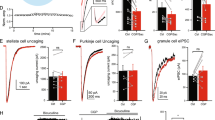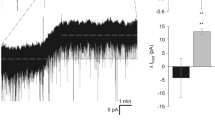Abstract
GABAA receptors mediate two different types of inhibitory currents: phasic inhibitory currents when rapid and brief presynaptic GABA release activates postsynaptic GABAA receptors and tonic inhibitory currents generated by low extrasynaptic GABA levels, persistently activating extrasynaptic GABAA receptors. The two inhibitory current types are mediated by different subpopulations of GABAA receptors with diverse pharmacological profiles. Selective antagonism of tonic currents is of special interest as excessive tonic inhibition post-stroke has severe pathological consequences. Here we demonstrate that phasic and tonic GABAA receptor currents can be selectively inhibited by the antagonists SR 95531 and the 4-PIOL derivative, 4-(3,3-diphenylpropyl)-5-(4-piperidyl)-3-isoxazolol hydrobromide (DPP-4-PIOL), respectively. In dentate gyrus granule cells, SR 95531 was found approximately 4 times as potent inhibiting phasic currents compared to tonic currents (IC50 values: 101 vs. 427 nM). Conversely, DPP-4-PIOL was estimated to be more than 20 times as potent inhibiting tonic current compared to phasic current (IC50 values: 0.87 vs. 21.3 nM). Consequently, we were able to impose a pronounced reduction in tonic GABA mediated current (>70 %) by concentrations of DPP-4-PIOL, at which no significant effect on the phasic current was seen. Our findings demonstrate that selective inhibition of GABA mediated tonic current is possible, when targeting a subpopulation of GABAA receptors located extrasynaptically using the antagonist, DPP-4-PIOL.



Similar content being viewed by others
References
Whiting PJ (2003) GABA-A receptor subtypes in the brain: a paradigm for CNS drug discovery? Drug Discov Today 8:445–450. doi:10.1016/S1359-6446(03)02703-X
Barnard EA, Skolnick P, Olsen RW et al (1998) International union of pharmacology. XV. Subtypes of gamma-aminobutyric ACIDA receptors: classification on the basis of subunit structure and receptor function. Pharmacol Rev 50:291–314
Stell BM, Mody I (2002) Receptors with different affinities mediate phasic and tonic GABA(A) conductances in hippocampal neurons. J Neurosci 22(RC223):2002.
Mody I (2001) Distinguishing between GABA(A) receptors responsible for tonic and phasic conductances. Neurochem Res 26:907–913
Brickley SG, Cull-Candy SG, Farrant M (1996) Development of a tonic form of synaptic inhibition in rat cerebellar granule cells resulting from persistent activation of GABAA receptors. J Physiol 497(Pt 3):753–759
Scimemi A, Semyanov A, Sperk G et al (2005) Multiple and plastic receptors mediate tonic GABAA receptor currents in the hippocampus. J Neurosci 25:10016–10024. doi:10.1523/JNEUROSCI.2520-05.2005
Nusser Z, Sieghart W, Somogyi P (1998) Segregation of different GABAA receptors to synaptic and extrasynaptic membranes of cerebellar granule cells. J Neurosci 18:1693–1703
Stell BM, Brickley SG, Tang CY et al (2003) Neuroactive steroids reduce neuronal excitability by selectively enhancing tonic inhibition mediated by delta subunit-containing GABAA receptors. Proc Natl Acad Sci USA 100:14439–14444. doi:10.1073/pnas.2435457100
Sur C, Quirk K, Dewar D et al (1998) Rat and human hippocampal alpha5 subunit-containing gamma-aminobutyric ACIDA receptors have alpha5beta3gamma2 pharmacological characteristics. Mol Pharmacol 54:928–933. doi:10.1124/mol.54.5.928
Saxena NC, Macdonald RL (1996) Properties of putative cerebellar gamma-aminobutyric acid a receptor isoforms. Mol Pharmacol 49:567–579
Brown N, Kerby J, Bonnert TP et al (2002) Pharmacological characterization of a novel cell line expressing human alpha(4)beta(3)delta GABA(A) receptors. Br J Pharmacol 136:965–974. doi:10.1038/sj.bjp.0704795
Clarkson AN, Huang BS, Macisaac SE et al (2010) Reducing excessive GABA-mediated tonic inhibition promotes functional recovery after stroke. Nature 468:305–309. doi:10.1038/nature09511
Sur C, Quirk K, Dewar D et al (1998) Rat and human hippocampal alpha5 subunit-containing gamma-aminobutyric ACIDA receptors have alpha5 beta3 gamma2 pharmacological characteristics. Mol Pharmacol 54:928–933
Atack JR, Bayley PJ, Seabrook GR et al (2006) L-655,708 enhances cognition in rats but is not proconvulsant at a dose selective for alpha5-containing GABAA receptors. Neuropharmacology 51:1023–1029. doi:10.1016/j.neuropharm.2006.04.018
Pavlov I, Huusko N, Drexel M et al (2011) Progressive loss of phasic, but not tonic, GABAA receptor-mediated inhibition in dentate granule cells in a model of post-traumatic epilepsy in rats. Neuroscience 194:208–219. doi:10.1016/j.neuroscience.2011.07.074
Mtchedlishvili Z, Lepsveridze E, Xu H et al (2010) Increase of GABAA receptor-mediated tonic inhibition in dentate granule cells after traumatic brain injury. Neurobiol Dis 38:464–475. doi:10.1016/j.nbd.2010.03.012
Frølund B, Jørgensen AT, Tagmose L et al (2002) Novel class of potent 4-arylalkyl substituted 3-isoxazolol GABA(A) antagonists: synthesis, pharmacology, and molecular modeling. J Med Chem 45:2454–2468
Krehan D, Storustovu SI, Liljefors T et al (2006) Potent 4-arylalkyl-substituted 3-isothiazolol GABA(A) competitive/noncompetitive antagonists: synthesis and pharmacology. J Med Chem 49:1388–1396. doi:10.1021/jm050987l
Glykys J, Mody I (2006) Hippocampal network hyperactivity after selective reduction of tonic inhibition in GABA A receptor alpha5 subunit-deficient mice. J Neurophysiol 95:2796–2807. doi:10.1152/jn.01122.2005
Glykys J, Mody I (2007) The main source of ambient GABA responsible for tonic inhibition in the mouse hippocampus. J Physiol 582:1163–1178. doi:10.1113/jphysiol.2007.134460
Vardya I, Hoestgaard-Jensen K, Nieto-Gonzalez JL et al (2012) Positive modulation of δ-subunit containing GABA(A) receptors in mouse neurons. Neuropharmacology 63:469–479. doi:10.1016/j.neuropharm.2012.04.023
Vestergaard HT, Cannillo C, Frølund B, Kristiansen U (2007) Differences in kinetics of structurally related competitive GABA(A) receptor antagonists. Neuropharmacology 52:873–882. doi:10.1016/j.neuropharm.2006.10.004
Mtchedlishvili Z, Kapur J (2006) High-affinity, slowly desensitizing GABAA receptors mediate tonic inhibition in hippocampal dentate granule cells. Mol Pharmacol 69:564–575. doi:10.1124/mol.105.016683
Glykys J, Mann EO, Mody I (2008) Which GABA(A) receptor subunits are necessary for tonic inhibition in the hippocampus? J Neurosci 28:1421–1426. doi:10.1523/JNEUROSCI.4751-07.2008
Soltesz I, Smetters DK, Mody I (1995) Tonic inhibition originates from synapses close to the soma. Neuron 14:1273–1283
Murphy TH, Corbett D (2009) Plasticity during stroke recovery: from synapse to behaviour. Nat Rev Neurosci 10:861–872. doi:10.1038/nrn2735
Vardya I, Drasbek KR, Dósa Z, Jensen K (2008) Cell type-specific GABA A receptor-mediated tonic inhibition in mouse neocortex. J Neurophysiol 100:526–532. doi:10.1152/jn.01224.2007
Wlodarczyk AI, Sylantyev S, Herd MB et al (2013) GABA-independent GABAA receptor openings maintain tonic currents. J Neurosci 33:3905–3914. doi:10.1523/JNEUROSCI.4193-12.2013
Lüddens H, Seeburg PH, Korpi ER (1994) Impact of beta and gamma variants on ligand-binding properties of gamma-aminobutyric acid type A receptors. Mol Pharmacol 45:810–814
Ebert B, Thompson SA, Saounatsou K et al (1997) Differences in agonist/antagonist binding affinity and receptor transduction using recombinant human gamma-aminobutyric acid type A receptors. Mol Pharmacol 52:1150–1156
Conflict of interest
The authors declare that they have no conflict of interest.
Author information
Authors and Affiliations
Corresponding author
Rights and permissions
About this article
Cite this article
Boddum, K., Frølund, B. & Kristiansen, U. The GABAA Antagonist DPP-4-PIOL Selectively Antagonises Tonic over Phasic GABAergic Currents in Dentate Gyrus Granule Cells. Neurochem Res 39, 2078–2084 (2014). https://doi.org/10.1007/s11064-014-1397-9
Received:
Revised:
Accepted:
Published:
Issue Date:
DOI: https://doi.org/10.1007/s11064-014-1397-9




